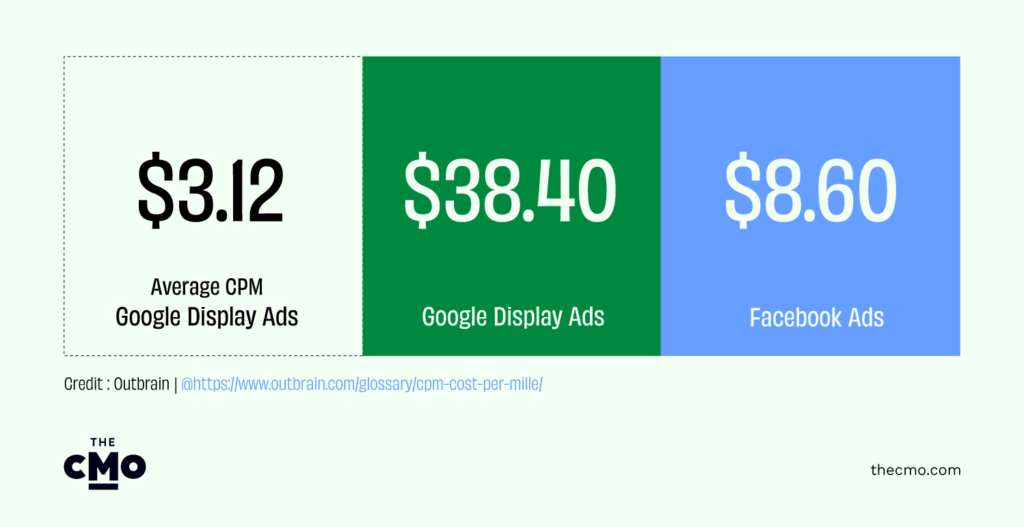Understanding the intricacies of pricing models is paramount to marketing. Why? Because it forms the bedrock of effective marketing strategies. Among these, CPM, or Cost per Mille, stands as a fundamental pillar. With a clear grasp of advertising pricing models, advertisers can avoid overspending, and misjudging audience reach.
But what exactly is CPM, and how does it shape the landscape of advertising strategies? In this article, I have explained the meaning of CPM, how to calculate it, the advantages of using the CPM model, and how to optimize it for better ROI. I have also explained how it differs from other advertising models.
What Is CPM And Why Does It Matter?
In the marketing and advertising world, CPM is a popular metric and pricing model that stands for ‘Cost per Mille’. It measures the cost an advertiser pays on average for 1,000 ad impressions. ‘Mille’ is a Latin word that stands for ‘one thousand’ and impression refers to a single instance of an ad being displayed on a webpage or app to a user.
For example, a CPM of $6 means that the advertiser paid $6 for every 1,000 ad impressions.

CPM Formula
The CPM (Cost Per Mille) formula helps determine the cost incurred for every thousand ad impressions. Here's how you can calculate it:
CPM formula = (total advertising cost ÷ total ad impressions) × 1000
In this equation, 'total cost' represents the total ad spend, and 'impressions' refers to the total number of impressions. By utilizing this formula, advertisers can evaluate whether the cost they're incurring is reasonable and whether these impressions are leading to desired outcomes, such as clicks, conversions, or brand awareness.
Based on the calculation, you can adjust your CPM campaigns. For example, if the CPM is high, it might indicate that the campaign needs adjustments. Advertisers could consider changing targeting parameters, adjusting the ad's creative elements, or even choosing a different platform altogether.
CPM Calculation Example
Let's walk through an example of how to calculate CPM:
Suppose a company runs an online advertising campaign for a new product. They spend $2,000 on the campaign, and their ad gets displayed 300,000 times.
Using the CPM formula:
CPM formula = (total advertising cost ÷ total ad impressions) × 1000
CPM = (2000 ÷ 300,0000) × 1000
CPM = 6.6
In this example, the CPM rate for the campaign is approximately $6. This means that the company spent $6 for every one thousand impressions of their ad.
This information will help the company assess the cost-effectiveness of its campaign compared to its marketing efforts. They can use this CPM value to make informed decisions about their advertising budget and strategy for future campaigns.
CPM Vs. CPC Vs. CPA
CPM (Cost Per Mille), CPC (Cost Per Click), and CPA (Cost Per Action) are three fundamental pricing models in digital advertising, each designed to achieve distinct campaign objectives. As discussed, CPM tells the cost per thousand impressions. CPC shows the cost per ad click and CPA indicates the cost for each action.
Let's explore each of these in more detail:
CPM (Cost Per Mille):
- Definition: CPM charges advertisers for every one thousand impressions (displays) of their ad, regardless of whether a user interacts with it or not.
- Use Case: CPM is ideal for brand awareness campaigns where the primary goal is to maximize exposure and reach a large audience. Through consistent and repeated exposure, CPM aids in building brand recognition. When users encounter the brand multiple times, it reinforces its presence in their minds.
CPC (Cost Per Click):
- Definition: CPC is a popular advertising model used by ad networks like Facebook, Google Ads, etc. CPC charges advertisers only when a user clicks on their display ad, which means advertisers pay for actual engagement with the content. It is also known as pay-per-click (PPC).
- Use Case: CPC is well-suited for campaigns that drive traffic to a website or specific landing page. It's also a good indicator of how well your ads are performing.
CPA (Cost Per Action):
- Definition: CPA charges advertisers based on a specific action the user takes, such as a purchase, form submission, or other desired outcome. Advertisers only pay when the defined action occurs. For example, these actions include signing up for a newsletter, filling out a contact form, completing a sale, etc. CPA is also known as cost per acquisition.
- Use Case: CPA is particularly valuable for campaigns with a clear and specific conversion goal. It's commonly used for direct-response advertising, where the primary objective is to acquire customers, leads, or other valuable actions.
As discussed, CPM isn’t the only display advertising model. There are other models like CPC and CPA, but you might be wondering which one you should choose. The answer hinges on your advertising goals.
If your primary goal is to raise brand awareness, CPM is the go-to model. It ensures that your ad is seen by a wide audience, though engagement isn't guaranteed. On the other hand, if you're looking to drive traffic and ensure active user engagement, CPC is your best bet. You'll only pay when users click, making it a cost-effective approach. Finally, CPA proves invaluable when your main aim is precise conversions. You only pay when a specific action, like a form submission or a sale, is completed. While setting up a CPA campaign might require more upfront effort, it's tailored for targeted results.
Ultimately, there's no one-size-fits-all solution. The right model hinges on your unique goals, audience, and budget. Often, a blend of these models is employed to create a well-rounded advertising strategy.
Benefits Of Using CPM For Marketing
CPM offers several advantages, making it one of the most common advertising models. Firstly, it provides a predictable cost structure, allowing advertisers to plan and budget their campaigns effectively. With CPM, you pay a fixed rate for every thousand impressions, providing clarity on the expenses involved.
Additionally, many other benefits of CPM exist such as brand exposure to a broad audience, regardless of click-through rates. This is particularly valuable for brand awareness campaigns where the primary goal is to reach as many potential customers as possible. Moreover, it enables precise targeting options, ensuring that your ads are shown to the right audience based on demographics, interests, and behavior. This results in more relevant ad placements and potentially higher engagement rates.
Another benefit of the CPM pricing model is that it is budget-friendly. It offers a lower cost compared to other models like CPA and CPC. In the second quarter of 2023, the average CPM on social media was $5.33.
7 Simple Tips To Optimize CPM ROI
Optimizing the ROI of CPM advertising campaigns requires a strategic approach. Here are seven straightforward yet powerful tips to help you optimize your CPM ROI and achieve better results:
1. Understand Your Audience
Understanding your target audience is the foundation for crafting relevant advertisements that resonate with potential customers. When advertisers understand their target customers, they can tailor their messaging, creatives, and placement strategies to align with their target demographic's preferences, behaviors, and interests.
So, conduct thorough market research to gain insights into your ideal customers. Here are some tips on how you can learn about your ideal audience:
- Conduct customer surveys: Direct feedback from existing customers through surveys, feedback forms, or interviews can provide invaluable insights into their needs, preferences, and pain points.
- Monitor social media platforms: You can use social media analytics software or social listening tools for discussions, comments, and conversations related to your industry, product, or service. This can reveal customer sentiment, common issues, and trending topics.
- Create detailed user personas: User personas are fictional characters representing different segments of your target audience. This helps in understanding their motivations, needs, and pain points.
2. Create Quality Content
Ensure your ads are visually appealing, concise, and provide clear value to your audience. High-quality content not only captures attention but also encourages users to take the desired action. To create quality ads, below are some steps you can take:
- Define the objective of the ad: Whether it's to increase brand awareness, drive website visits, generate leads, or promote a sale, clarity will inform the content and call-to-action.
- Add engaging visuals: Incorporate eye-catching images, videos, or graphics relevant to your message and ad format. High-quality visuals can significantly impact the effectiveness of your ad.
- Include a clear call-to-action (CTA): Clearly state what action you want the viewer to take. Whether it's "Shop Now," or "Sign Up," the CTA should be compelling and easy to understand.
- Optimize the ad for mobile devices: Ensure that your ad content is mobile-friendly. With 55% of internet traffic coming from mobile devices, your ad must look and function well on smaller screens.
- Use digital marketing software: For asset creation and distribution with a built-in proofing/approval system to ensure every piece of content is showcasing your brand in the best light.
3. Use Effective Targeting
Utilize targeting options provided by advertising platforms to reach the right audience. This may include demographic targeting, geographic targeting, interests, behaviors, and more. Narrowing down your audience ensures that your ads are shown to people who are more likely to be interested in your products or services.
4. A/B Testing
Experiment with different ad creatives, headlines, and copy to identify what resonates best with your audience. A/B testing allows you to compare the performance of different elements and make data-driven decisions to improve your ad campaigns over time.
By consistently testing and iterating on your ad content and targeting parameters, you can refine your approach and achieve even more impactful results over time. This data-driven approach ensures that your advertising efforts are continuously evolving to meet your audience's changing preferences and behaviors.
5. Optimize Ad Scheduling
Analyze when your target audience is most active online. By scheduling your ads to display during these peak times, you increase the likelihood of capturing their attention. This can lead to higher engagement rates and ultimately better ROI.
Take into account the seasonal patterns and relevant events that may impact your target audience's behavior. Tailor your ad scheduling to align with these trends. For example, if you sell holiday decorations, ramp up your advertising efforts leading up to major holidays. Similarly, if you offer products or services related to specific events or seasons (like back-to-school supplies or summer vacations), adjust your ad schedule accordingly.
6. Use Retargeting
Implement retargeting campaigns to re-engage users who have previously interacted with your website or shown interest in your products. This can be highly effective in converting potential customers who may have not made a purchase during their initial visit.
Also, use marketing measurement tools to improve retargeting campaigns. You can:
- Implement conversion tracking on your website, utilizing platforms like Google Analytics or Facebook Pixel. This allows you to monitor user actions after interacting with retargeting ads.
- Segment your audience based on behavior and interactions using marketing automation or CRM systems.
- Utilize A/B testing to compare different ad elements for better performance.
7. Monitor and Adjust
Lastly, regularly track the performance of your CPM marketing campaigns. Analyze metrics such as click-through rates, conversion rates, and ROI. Based on the data, make necessary adjustments to your targeting or content to optimize for better results.
Conclusion
CPM not only establishes a foundational pricing method but plays a crucial role in digital marketing analytics. Like other advertising strategies, CPM requires ongoing testing, analysis, and iteration, for which you can rely on digital marketing analytics tools.
These tools will help you fine-tune your targeting, messaging, and creative elements. If you're interested in exploring such tools, we regularly feature them on our blog. Feel free to visit the tools section on our blog for more info.
Additionally, if you're eager to expand your knowledge on CPM and other key marketing terms, check out our article on marketing efficiency ratio and consider subscribing to The CMO newsletter.


